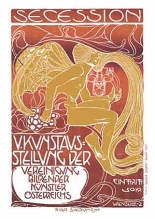::Other Links::

 |
| A poster for the Vienna Secession by Koloman Moser |
Art Nouveau is seen as being the first truly new and perhaps non-conformist artistic form, in which the past was not consulted or looked to with reverence. For the first time, artists made use of new materials (such as iron and glass in sculpture) in pursuit of an artistic style that was entirely pure from past-styles, which was to span all artistic forms ranging from architecture and painting to furniture design and much more.
Although the rebellious Art Nouveau movement was primarily popular within Europe, it also had influence within the United States. Art Nouveau movements sprang up all over in response to the oppresive and inspirationless nature of 19th century art, in Germany they called it jugendstil, in Spain it was modernismo and in Austria it was the sezessionstil, where the movement coined the phrase "to the age its art - and to art its freedom" which words can still be read inscribed above the secession building, which was built specifically for exhibitions of art nouveau themed work after their break from the typically conservative Künstlerhaus.
Though despite attempts at breaking from the influence of the past, much work from art nouveau artists contained influences from post-impressionism and symbolism, Klimt being testament to this.
However, although an international movement, the art nouveau movement fell out of favor by the beginning of the First World War as the artistic and lavish design was often expensive to produce. It fell out of fashion in favor of the more simplistic Art Deco. Although art nouveau underwent a semi-revival during the 1960s, for the most part by the middle of the 20th century both artistic styles were largely unpopular and doomed to an eternity as collectors pieces.